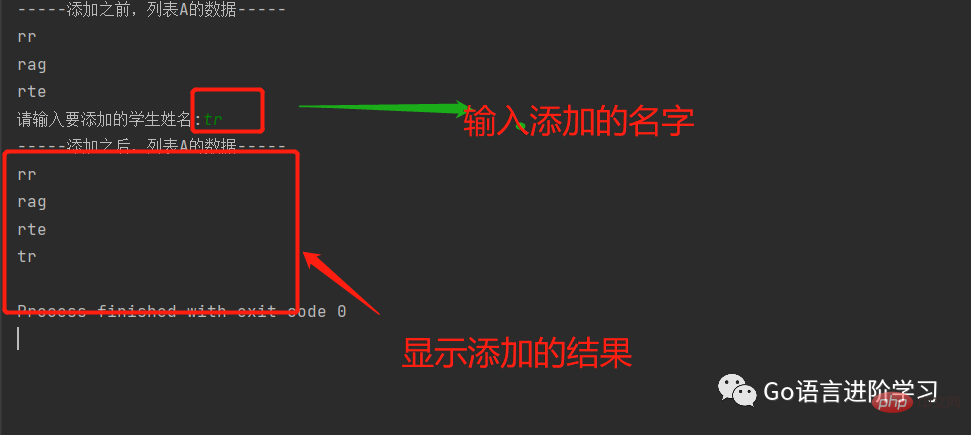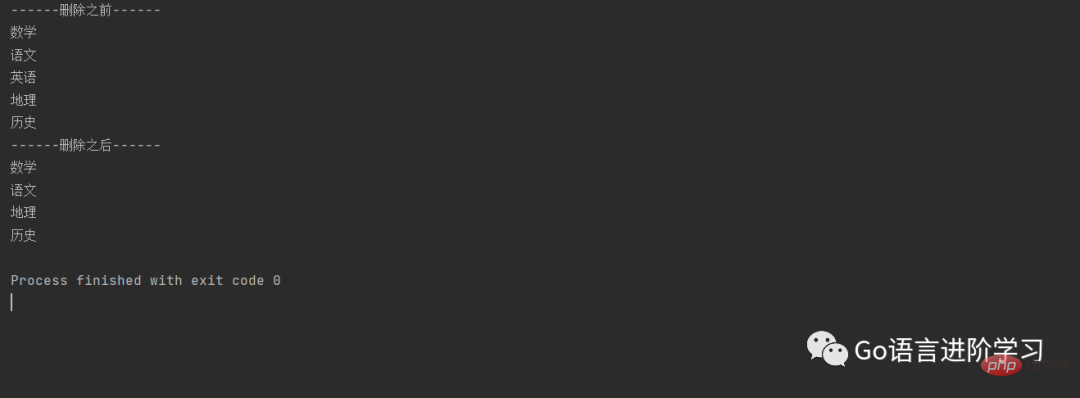
Example:
namesList = ['xiaoWang','xiaoZhg','xiaa']
is more powerful than the C language array The point is that the elements in the list can be of different types. <br/>
testList = [1, 'a']
<1> Add elements
append() You can add elements to the list through append.
Example:
# 定义变量A,默认有3个元素
A = ['rr', 'rag', 'rte']
print("-----添加之前,列表A的数据-----")
for tempName in A:
print(tempName)
# 提示、并添加元素
temp = input('请输入要添加的学生姓名:')
A.append(temp)
print("-----添加之后,列表A的数据-----")
for tempName in A:
print(tempName)Run result:<br/>

<2> Modify elements ("change")<br/>
When modifying elements, you must use the subscript to determine what you want to modify. which element it is before it can be modified.
Example:
# 定义变量A,默认有3个元素
A = ['rr', 'rag', 'rte']
print("-----修改之前,列表A的数据-----")
for tempName in A:
print(tempName)
# 修改元素
A[1] = 'Lu'
print("-----修改之后,列表A的数据-----")
for tempName in A:
print(tempName)Result:<br/>

<3> 查找元素("查"in, not in, index, count)<br/>
python中查找的常用方法为:
in(存在),如果存在那么结果为true,否则为false。
not in(不存在),如果不存在那么结果为true,否则false。
<br/>
#待查找的列表 A = ['rr', 'rag', 'rte']
#获取用户要查找的名字 findName = input('请输入要查找的内容:')
#查找是否存在 if findName in A: print('在字典中找到了相同的内容') else: print('没有找到')运行结果:(找到)<br/>

运行结果:(没有找到)

注:<br/>
in的方法只要会用了,那么not in也是同样的用法,只不过not in判断的是不存在。
<4> 删除元素("删"del, pop, remove)
del (根据下标进行删除)
<br/>
Name = ['加勒比海盗','骇客帝国','第一滴血','霍比特人','速度与激情'] print('------删除之前------')for tempName in Name: print(tempName) del Name[2] print('------删除之后------')for tempName in Name: print(tempName)
结果:<br/>

pop(删除最后一个元素)
Subject= ['数学', '语文', '英语', '地理', '历史'] print('------删除之前------')for tempSubject in Subject: print(tempSubject) del Subject[2] #删除第二个元素 print('------删除之后------')for tempSubject in Subject: print(tempSubject)
运行结果:

remove (根据元素的值进行删除)
<br/>
Subject= ['数学', '语文', '英语', '地理', '历史'] print('------删除之前------')for tempSubject in Subject: print(tempSubject) # del Subject[2] #删除第二个元素Subject.remove('英语') print('------删除之后------')for tempSubject in Subject: print(tempSubject)
结果:<br/>

<5> 排序(sort, reverse)
sort方法是将list按特定顺序重新排列,默认为由小到大,参数reverse=True可改为倒序,由大到小。
reverse方法是将list逆置。
a = [1, 4, 2, 3]print(a) a.reverse()print(a) # 运行结果a.sort()print(a) # 运行结果a.sort(reverse=True)print(a) # 运行结果
运行结果:<br/>

<br/>
类似while循环的嵌套,列表也是支持嵌套的。
一个列表中的元素又是一个列表,那么这就是列表的嵌套。
例:
Letter= [['A', 'B'], ['C', 'D', 'E'], ['F', 'R']]
列表中包含字典。比如花名册:
pep1 = {'name': '蔡同学', 'school': '北京大学'}pep2 = {'name': '陈作同', 'school': '中山大学'}pep_list = [pep1, pep2]for pepo in pep_list: print(pepo)运行结果:<br/>

有的应用场景,会在列表中包含大量的字典, 而且其中的每个字典都会包含拥有众多属性的大对象。<br/>
字典包含列表。比如图书的标签,一本书会被标注多个标签:
book = {'title': '现代艺术150年', 'tags': ['数学', '历史学']}for tags in book['tags']: print(tags)运行结果:

本文详细的讲解了Python基础 。介绍了常见的列表操作,以及在实际操作中会遇到的问题,提供了解决方案。最后通过一个小项目,使读者能够更好的理解Python列表的使用方法。希望可以帮助你更好的学习。
The above is the detailed content of Things to take stock of the list of Python basics. For more information, please follow other related articles on the PHP Chinese website!